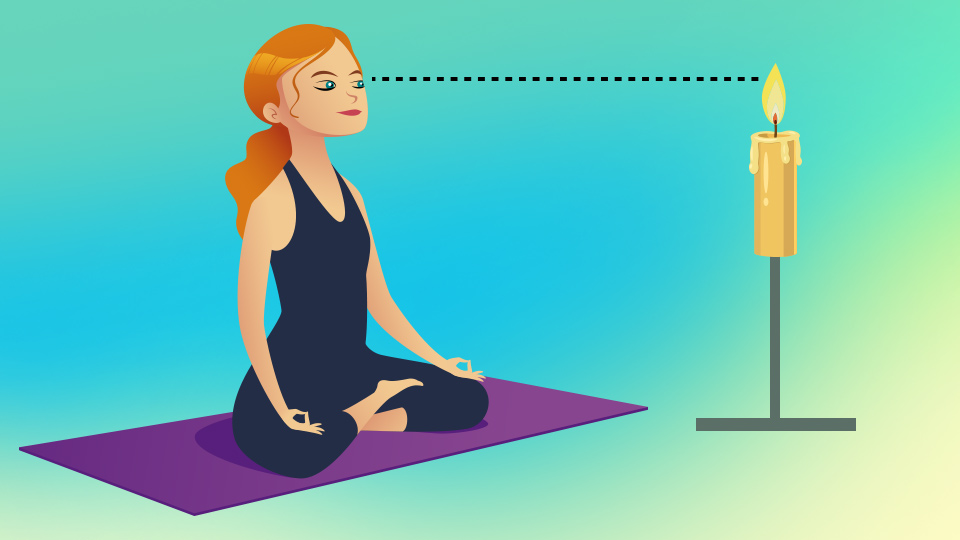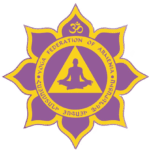How to do? : Light the candle and place it on a small table so that the flame is exactly at eye level when sitting. Sit in any comfortable meditation asana with the head and spine erect. Adjust the position so that the candle is an arm’s length away from the body. Close the eyes and relax the whole body, especially the eyes. Be aware of body steadiness for a few minutes. Keep the body absolutely still throughout the practice. Open the eyes and gaze steadily at the tip of the wick. The flame may flicker slightly but the tip of the wick will always remain steady. Try not to blink or move the eyeballs in any way. Do not strain as this will cause tension and the eyes will flicker. The awareness should be so completely centred on the wick that body awareness is lost. If the mind begins to wander, gently bring it back to the practice. After a minute or two, when the eyes become tired or begin to water, close them gently. Gaze at the after-image of the flame in the space in front of the closed eyes. If the image moves up or down, or from side to side, observe it and try to stabilise it. When the image of the flame begins to fade, try to bring it back. When the image can no longer be retained, gently open the eyes and gaze at the tip of the wick once more. Repeat the procedure for external gazing. Close the eyes once more and gaze at the inner image. Continue in this way 3 or 4 times. After completing the final round, practise palming 2 or 3 times, before opening the eyes (see chapter on eye exercises). This completes the practice.
Time of practice: Trataka may be performed at any time but the best time is at dawn or dusk when the stomach is empty.
Duration: Beginners should gaze for 1 or 2 minutes only. For general purposes 10 minutes is sufficient. For spiritual purposes or to rectify an eye defect, trataka may be per[1]formed for extended periods of time after consulting a qualified therapist or teacher. Those who suffer from insomnia and mental tension should perform this practice for 10 to 15 minutes before sleeping at night.
Sequence: Trataka should be performed after asanas and pranayamas and before japa or meditation.
Precautions: Trataka must be practised on a steady flame, so there should be no draught in the vicinity. The practitioner should always avoid undue strain. The ability to keep the eyes open without blinking should be developed gradually with consistent practice. Trataka is an excellent method for clearing accumulated complexes, problems and suppressed thoughts from the mind, enabling the practitioner to witness what is surfacing. It is also possible, however, for these problems to manifest too rapidly which may be mentally disturbing. If this occurs, stop the practice and seek advice from an expert yoga teacher. In case of eye ailments such as eyestrain, myopia, astigmatism and even the early symptoms of cataract, a black dot should be used instead of a candle flame.
Contra-indications: Epileptics should not practise trataka on a candle flame but should choose a totally steady object to gaze on. Benefits: This practice makes the eyes clear and bright. It balances the nervous system, relieving nervous tension, anxiety, depression and insomnia. It improves the memory and helps to develop good concentration and strong willpower. It activates ajna chakra and is an excellent preparation for meditation.
Variations: Trataka may be practised on any object of personal choice. However, it is not advisable to do trataka on the the moon, a crystal ball, a mirror or darkness as the experience may be too powerful to handle. Avoid practising trataka on the sun as the delicate membranes of the eyes may be damaged. Once the object has been chosen it should not be changed, otherwise the mind will have to start from the beginning again to assimilate the new object. So, choose carefully and then stick to the choice.
Practice note: The practice involves gazing at a fixed point or object without blinking the eyes. The aim is to focus the mind and curb its oscillating tendencies, making it one[1]pointed and awakening inner vision. All the attention and power of the mind is channelled into one continuous stream. This should be an effortless process, without strain. Once this has been achieved, the latent potential within the mind is able to arise spontaneously.
Note: The word trataka means ‘to look’ or ‘to gaze’. Trataka is the last of the shatkarmas. It acts as a stepping-stone between physically oriented practices and mental practices which lead to higher states of awareness. It forms a bridge between hatha yoga and raja yoga. Traditionally, it is a part of hatha yoga but it may also be considered a part of raja yoga.
Information
Թեմաներ
- art (1)
- Uncategorized (1)

